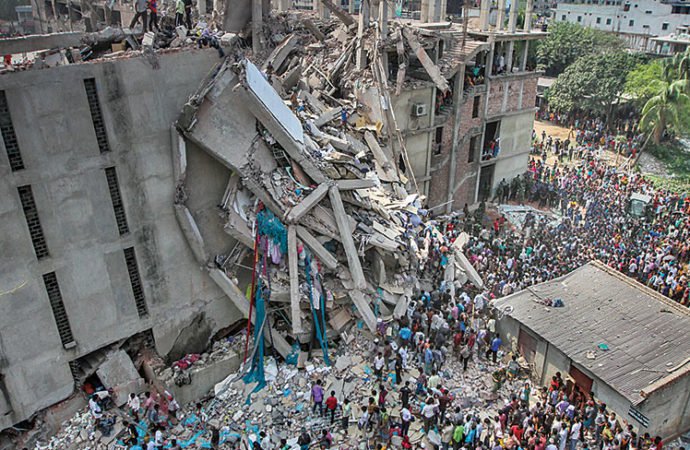Published in Reuters on April 24, 2018

Although safety is a higher priority five years on from the Rana Plaza disaster in Bangladesh that killed 1,135 garment workers, dangerous conditions persist in smaller factories, campaigners said.
Among the improvements needed, they said, are raising the minimum wage, regulating work hours, and mapping supply chains.
The collapse of the eight-storey building on the outskirts of the capital Dhaka on April 24, 2013 also injured more than 2,000 workers, sparking demands for better safety in the world’s second-largest exporter of readymade garments.
The accident saw brands, unions and the government set up initiatives to improve factory safety. However, many workers still “work at their own peril”, researchers said, despite “great progress in many of the largest and best factories”.
“Workers in thousands of subcontracting factories, many of them young women, continue to work under unacceptably dangerous conditions,” Michael Posner of New York University’s Stern Center for Business and Human Rights said in a statement.
Posner’s statement was part of a report released earlier this month that assessed the post-Rana Plaza work environment.
The report – “Five Years After Rana Plaza: The Way Forward” – estimated that up to 3,000 subcontractors help “mother factories manage their export workload”.
For many suppliers, subcontracting is a vital business practice that helps to compensate for ever-increasing production pressures, said report co-author Dorothée Baumann-Pauly.
“With falling prices and faster fashion, the need to rely on subcontractors may be greater than ever for suppliers, despite the risks involved in the practice,” she said.
Among the risks for workers, the report said, are that many smaller factories ignore safety rules, and operate out of unsafe buildings that lack fire exits, alarms and extinguishers.
WAKE-UP CALL
Parveen S Huda, who heads a project to map digitally every garment factory in Bangladesh, said her team was going street by street to count even the smallest manufacturing unit and ensure it was logged in the system.
“More than 1,000 workers did not die in vain. They opened our eyes to the extreme conditions of workers, and we are slowly moving from just safety aspects to a more holistic approach to protect the rights of workers,” she said.
Two agreements after the disaster saw retailers involved in initiatives to improve safety: the Bangladesh Accord on fire and building safety, and an alliance on worker safety.
Since then about 2,000 factories have been inspected, nearly 3 million workers have been trained on fire safety, and failings at many factories have been fixed. Other improvements include setting up helplines and forming safety committees in factories.
“Awareness is up, and calls on helplines are up,” said Michael Bride of the Bangladesh Accord.
“For years workers had been told that they shouldn’t run away, but stay and fight the fire. Now they understand that they need to evacuate, and have the right to refuse unsafe work.”
“CHEAP LABOR”
Despite the progress on safety, Bangladesh’s garment workers remain among the worst-paid in the world, a compensation report released by Fair Labor Association (FLA) on Tuesday stated.
The legal minimum wage of $66 is below the World Bank’s global poverty line of $85 and the Asia Floor Wage of $454. That means many workers must work overtime to supplement their wages, the FLA’s report said.
Overtime income accounts for 20 percent of their salary, it said, and half of the workers put in more than 60 hours a week despite the impact on their health.
“The ‘cheap labor’ branding of Bangladeshi workers needs to go,” Syed Sultan Uddin Ahmed of the Bangladesh Institute of Labor Studies told the Thomson Reuters Foundation in Dhaka.
“Within the factories, work conditions have improved in the last five years – but outside, the living conditions have not.”
WAY AHEAD
Posner at the Stern Center said it would cost $1.2 billion to fix poor conditions in subcontracting factories, and said a task force should be set up to count the number of factories and assess what it would cost to improve safety.
And, he added, a fund should be established by brands, governments and charities to help pay for improvements.
“Western consumers are the beneficiaries of the cheap clothes produced in Bangladesh. Therefore, it is incumbent on western brands and retailers, as well as western governments, to step up to the plate,” Posner said.
In a statement, members of the alliance for worker safety – a grouping of mostly U.S. retailers – said their factories had reached the “starting line for safety, not the finish line”, and called on brands, factory owners and the government to cement the gains made.
Unions have also called on more brands to get involved.
The FLA report said buyers sourcing from Bangladesh should support a higher minimum wage and assure suppliers that they would pay more to meet that cost.
“The work pressure, production targets, forced overtime and lack of social security makes the garment worker very vulnerable even today,” said Babul Akhter of the Bangladesh Garment and Industrial Workers’ Federation.
“Constant monitoring of the initiatives is required. The negotiating power of workers has to be strengthened to get them a fair deal for the clothes they stitch for global brands.”
 CPD RMG Study Stitching a better future for Bangladesh
CPD RMG Study Stitching a better future for Bangladesh



